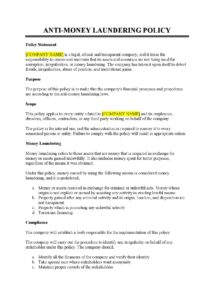Money laundering is a serious crime that can have devastating consequences for both individuals and businesses. This is why it is important to have a robust anti-money laundering (AML) compliance program in place. An effective AML compliance program will help you to identify and mitigate the risks of money laundering, and it will also protect your business from financial and reputational damage.
What is an Anti Money Laundering Compliance Program?
An anti-money laundering compliance program is a set of policies and procedures that are designed to prevent and detect money laundering. These programs typically include elements such as customer due diligence (CDD), transaction monitoring, and reporting suspicious activity. CDD involves verifying the identity of your customers and understanding their business activities. Transaction monitoring involves screening transactions for suspicious activity, such as large or unusual cash transactions. Reporting suspicious activity involves filing a report with the appropriate authorities when you suspect that money laundering is taking place.
An effective AML compliance program should be tailored to the specific risks that your business faces. The size of your business, the nature of your business, and the geographic locations in which you operate will all impact the type of AML compliance program that you need. It is important to work with a qualified professional to develop an AML compliance program that meets your specific needs.
Benefits of an Anti Money Laundering Compliance Program
There are many benefits to having an effective AML compliance program in place. These benefits include:
- Protecting your business from financial loss. Money laundering can lead to financial losses for businesses, as they can be held liable for the proceeds of money laundering activities.
- Protecting your business from reputational damage. Money laundering can damage the reputation of a business, as it can be seen as a sign that the business is involved in illegal activities.
- Complying with the law. Money laundering is a crime, and businesses are required by law to have an AML compliance program in place.
- Gaining a competitive advantage. Businesses that have a strong AML compliance program can gain a competitive advantage, as they are seen as being more trustworthy and reliable.
How to Develop an Anti Money Laundering Compliance Program
Developing an AML compliance program can be a complex and time-consuming process. It is important to work with a qualified professional to develop a program that meets your specific needs. The following steps can help you to develop an effective AML compliance program:
- Identify the risks that your business faces. The first step in developing an AML compliance program is to identify the risks that your business faces. This will help you to determine the type of program that you need.
- Develop policies and procedures. Once you have identified the risks that your business faces, you need to develop policies and procedures to address those risks. These policies and procedures should be documented and communicated to all employees.
- Train your employees. It is important to train your employees on your AML compliance program. This training should include information on the risks of money laundering, the policies and procedures that are in place to prevent and detect money laundering, and the reporting requirements for suspicious activity.
- Monitor your program. It is important to monitor your AML compliance program to ensure that it is effective. This monitoring should include regular reviews of your policies and procedures, as well as training for your employees.
Having an effective AML compliance program in place is essential for protecting your business from the risks of money laundering. By following the steps outlined above, you can develop a program that meets your specific needs and helps to protect your business.
